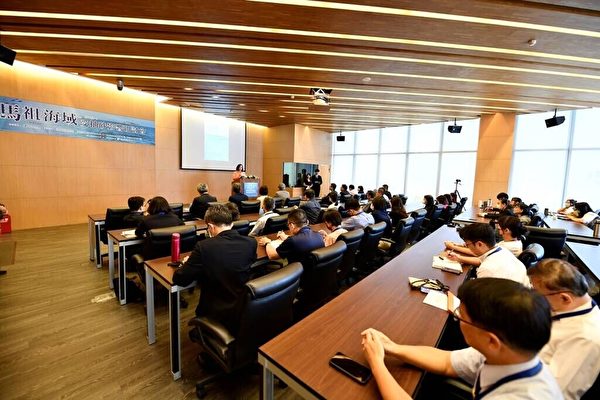The Chairperson of the Ocean Affairs Council of the Republic of China, Kuan Pi-ling, stated that with the efforts of lawmakers and strengthened enforcement by the Coast Guard Administration, the number of mainland sand dredging vessels illegally crossing into Taiwanese waters has decreased significantly after legal amendments.
On the 8th, the National Academy of Marine Research (NAMR) held a seminar on “The Impact of Sand Dredging in the Waters of Matsu” at the Kaohsiung Software Park Conference Center, bringing together representatives from government, academia, and industry to discuss the issue of sand dredging from various perspectives such as maritime law enforcement, marine conservation, and basic marine surveys. Presentations included insights from the Coast Guard Administration’s Kinmen-Matsu-Penghu Division on the “Current Situation of Cross-border Sand Dredging and Enforcement in the Waters of Matsu” and from the team conducting surveys on the population of the Matsu colonies of Swinhoe’s Storm Petrel on the “Monitoring and Conservation Status of Swinhoe’s Storm Petrel in Matsu.”
In her opening remarks, Kuan Pi-ling expressed her longstanding concern about the impact of mainland illegal sand dredging on the marine ecosystem of Taiwan when she served as a legislator in 2021. To combat rampant illegal sand dredging, she actively promoted amendments to the “Soil and Rock Extraction Act” and the “Republic of China Exclusive Economic Zone and Continental Shelf Act,” increasing penalties and allowing for the confiscation of sand dredging vessels, regardless of their ownership.
Kuan Pi-ling added that with legislative amendments and intensified efforts by the Coast Guard Administration, the number of mainland sand dredging vessels crossing into Taiwanese waters decreased from nearly 4,000 trips before the amendments to just 7 trips in the past year (2023). This achievement demonstrates Taiwan’s determination to protect its territory and marine resources, moving towards the goal of building a peaceful and sustainable marine environment.
Chen Chien-hung, the director of NAMR, stated that the institute is conducting a four-year project (2022-2025) to investigate and monitor the impact of illegal sand dredging in the waters of Matsu, focusing on seabed topography surveys, plankton and water quality investigations, and benthic ecology surveys. This year marks the third year of the project, with interim results being shared with the participants.
Regarding seabed topography surveys, Chen Chien-hung mentioned that using techniques such as multibeam bathymetry mapping, side-scan sonar, and magnetic seabed feature detection, NAMR completed surveys covering 150 square kilometers and 650 square kilometers of the Matsu waters in 2022 and 2023, respectively. The surveys identified remnants of sand dredging pipes and numerous non-natural excavation pits, indicating alterations to the seabed topography due to dredging activities, with variations mainly within a range of ±0.3 meters over the two years.
Furthermore, Chen Chien-hung highlighted that “in recent years, due to the vigorous enforcement actions by the Coast Guard Administration, illegal sand dredging activities have been effectively curtailed from entering restricted waters on our side. As a result, there have been fewer signs of new sand dredging activities in the hotspots and adjacent areas since 2022.”
Regarding plankton and water quality research in the marine environment, Chen Chien-hung explained that due to Matsu’s proximity to the mouth of the Minjiang River in China and a reduction in cross-border sand dredging activities last year, the hydrological environment of the region is primarily influenced by the flooding period of the Minjiang River and ocean current. The plankton composition is mainly affected by the influx of a large amount of inorganic nutrients, particularly silicon, carried by the Minjiang water during the flood season, leading to significant growth of diatoms.
In terms of benthic ecology surveys, he noted that NAMR has documented a total of 113 species of fish in the waters of Matsu through research trawling operations. The surveys identified the Matsu waters as important breeding grounds for economically valuable species of the Gobiidae family (such as gobies) and the Engraulidae family (such as anchovies). The biological abundance in non-dredged areas was found to be higher compared to areas affected by sand dredging.
Regarding the composition of benthic microbial communities, he pointed out that dredged areas have a higher proportion of heterotrophic bacteria, while non-dredged areas have a higher proportion of autotrophic bacteria, suggesting that past dredging activities may have influenced the microbial community structure of the seabed.
NAMR stated that the main purpose of the seminar was to share the interim results of the project currently being implemented, with ongoing marine ecological survey projects aimed at continuously building comprehensive survey data for the waters of Matsu. Following the seminar, NAMR will convene a joint working meeting on the implementation strategy to enhance the effectiveness of the project outcomes and present scientific evidence through marine research to international platforms, jointly condemning the destructive practices of illegal sand dredging vessels in the marine ecological resources of the Matsu region.

